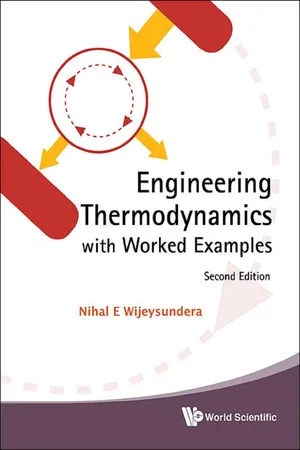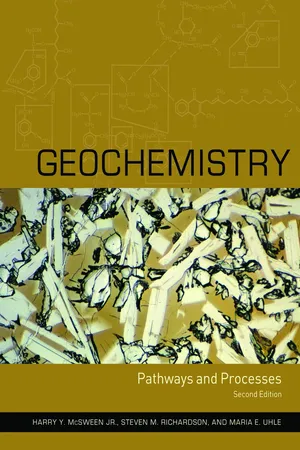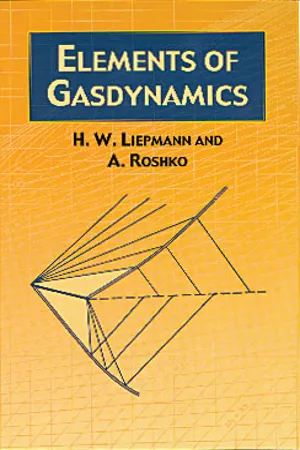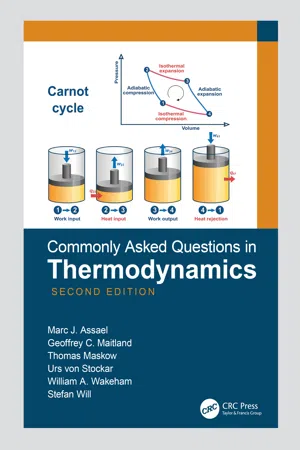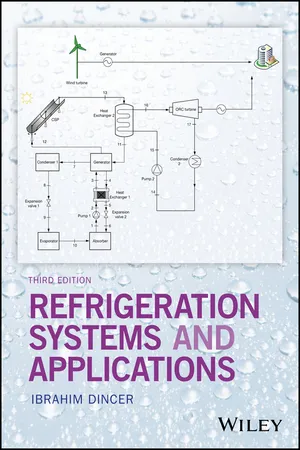Technology & Engineering
Thermodynamic State
Thermodynamic state refers to the condition of a system as described by its temperature, pressure, and other relevant properties. It is a fundamental concept in thermodynamics, providing a snapshot of the system's physical state at a specific point in time. Understanding the thermodynamic state of a system is crucial for analyzing and predicting its behavior and energy interactions.
Written by Perlego with AI-assistance
Related key terms
Related key terms
1 of 4
Related key terms
1 of 3
9 Key excerpts on "Thermodynamic State"
- eBook - ePub
- David R. Gaskell, David E. Laughlin(Authors)
- 2017(Publication Date)
- CRC Press(Publisher)
Chapter 2 .The system may be a machine (heat engine) or a device (transducer) of interest to us. In the study of the thermodynamics of materials, the system is usually composed of matter, which is anything that has mass and occupies space. Matter has a given temperature, pressure, and chemical composition, as well as physical properties such as thermal expansion, compressibility, heat capacity, viscosity, and so on. A central aim of applied thermodynamics is the determination of the effect of the surroundings on the equilibrium state of a given system. Since the surroundings interacts with the system by transferring or receiving various forms of energy or matter with it, another focus of applied thermodynamics is the establishment of the relationships which exist between the equilibrium state of a given system and the influences which have been brought to bear on it.1.2THE CONCEPT OF STATEA fundamental concept in thermodynamics is that of the thermodynamic state . If it were possible to know the masses, velocities, positions, and all modes of motion (translational, rotational, etc.) of all of the constituent particles in a system, this knowledge would serve to describe the microscopic state of the system, which, in turn, would determine, in principle, all of the thermodynamic variables of the system that can be measured (energy, temperature, pressure, etc.). For systems with macroscopic dimensions, this would entail more than 1024 coordinates, which is clearly an impossible task. In the absence of such detailed knowledge as is required to determine the microscopic state of the system, classical thermodynamics begins with a consideration of the variables of the system, which, when determined, completely define the macroscopic state of the system; that is, when all of the thermodynamic variables are fixed, then the macroscopic state of the system is fixed and is said to be in equilibrium. It is found that when the values of a small number of thermodynamic variables are fixed, the values of the rest of the thermodynamic variables are also fixed. Indeed, when a simple system such as a given quantity of a substance of fixed composition is being considered, the fixing of the values of two of the thermodynamic variables fixes the values of the rest of the thermodynamic variables. Thus, only two thermodynamic variables are independent, which, consequently, are called the independent thermodynamic variables of the system. All of the other variables are dependent variables . The Thermodynamic State of such a system is thus uniquely determined when the values of the two independent variables are fixed. This has been called the Duhem*postulate - eBook - ePub
- Howard Reiss(Author)
- 2012(Publication Date)
- Dover Publications(Publisher)
Another source of confusion which may arise in connection with the above definition concerns the reproducibility of the equilibrium state. Once it has been ascertained that the properties of the system are not changing with time and that a steady state is not involved, it may still be impractical to treat the system by the methods of thermodynamics. Before thermodynamics can be applied effectively, the experimenter must be able to reproduce the state at will. To accomplish this, he must know what variables determine the state; and even more important, he must be able to control these variables. As an example, a solid may be prepared in many states which meet the requirement of invariance to time (at least during the time of a measurement). But each of these states may be complicated by the fact that the solid contains an array of internal strains. To each distinct set of strains will correspond (under our definition) another state of equilibrium. The strains themselves are variables of the system, and unless we can control them and reproduce them, it will not be practical to employ the methods of thermodynamics.4. Thermodynamic State, Variables of State
We are now in a position to define a Thermodynamic State, a term which, unless otherwise specified, will be restricted to the description of systems at equilibrium. If the thermodynamic properties of a system at equilibrium are observed, it will be noted that whenever a certain number of them assumes certain numerical values all the remaining properties take on perfectly definite values. For example, in the case of a substance like water, whenever a given mass1 has a certain temperature and pressure, the volume of that mass will be determined in the sense that whenever the values of temperature and pressure are reproduced so will be the value of its volume. Alternatively, whenever the temperature and volume assume certain values, the pressure will be perfectly well defined. In order for all the properties to be reproduced, it is only necessary that the same number of them be reproduced. This number is called the degrees of freedom , or the number of independent variables of the system. A Thermodynamic State is then defined in terms of the independent variables, each set of values for the independent variables corresponding to a state. For a macroscopic system, the number of independent thermodynamic variables is usually small. By contrast, if it were necessary to describe the microscopic state of some thermodynamic system, say a mole of water, it would be necessary to specify the values of the coordinates of position and momentum for all the elementary particles constituting that mole. Thus, the number of independent microscopic variables might be as high as 1024 or 1025 - eBook - ePub
- Nihal E Wijeysundera(Author)
- 2016(Publication Date)
- WSPC(Publisher)
Chapter 1
Thermodynamic Systems and Properties
In this chapter we shall introduce some of the important concepts and definitions that provide the basic framework for the study of engineering thermodynamics. The logical development and generalization of the first and second laws of thermodynamics in later chapters of the book rely on these concepts and definitions.1.1Thermodynamics
Thermodynamics deals with energy and matter, their transformations and the interactions between them. Since all engineering systems involve energy and matter, the applications of thermodynamics are very broad. Mechanical and chemical engineering are two of the traditional branches of engineering where applications of thermodynamics abound. Although the laws of thermodynamics are universally valid, their presentation and the mode of development could vary according to the engineering discipline.1.2Systems and Surroundings
For the analysis of physical situations involving matter and energy, it is useful to isolate regions or entities on which attention may be focused with a view to applying the laws of thermodynamics. These regions or entities are called thermodynamic systems . A real or imaginary boundary is drawn to physically demarcate and clearly identify the system. The boundary may be fixed or deformable. Everything that lies outside the boundary constitutes the surroundings . Systems can be further categorized based on the type of matter and energy interactions between them and their surroundings. These interactions occur across the boundary.1.2.1Closed-system or control-mass
A system where there is no matter transfer across the boundary is called a closed-system or a control-mass . Note, however, that energy interactions may occur across the boundary.1.2.2Open-system or control-volume
For an open-system or control-volume - eBook - ePub
Geochemistry
Pathways and Processes
- Harry McSween, Steven Richardson, Maria Uhle(Authors)
- 2003(Publication Date)
- Columbia University Press(Publisher)
CHAPTER THREE A FIRST LOOK AT THERMODYNAMIC EQUILIBRIUM OVERVIEWIn this chapter, we introduce the foundations of thermodynamics. A major goal is to establish what is meant by the concept of equilibrium, described informally in the context of the party example in chapter 1 . The idea of equilibrium is an outgrowth of our understanding of three laws of nature, which describe the relationship between heat and work and identify a sense of direction for change in natural systems. These laws are the heart of the subject of thermodynamics, which we apply to a variety of geochemical problems in later chapters.TEMPERATURE AND EQUATIONS OF STATETo reach our goal, we need to examine some familiar concepts like temperature, heat, and work more closely. It is also necessary to introduce new quantities such as entropy, enthalpy, and chemical potential. The search for a definition of equilibrium also reveals a set of four fundamental equations that describe potential changes in the energy of a system in terms of temperature, pressure, volume, entropy, and composition.It is part of our everyday experience to arrange items on the basis of how hot they are. In a colloquial sense, our notion of temperature is associated with this ordered arrangement, so that we speak of items having higher or lower temperatures than other items, depending on how “hot” or “cool” they feel to our senses. In the more rigorous terms we must use as geochemists, though, this casual definition of temperature is inadequate for two reasons. First of all, a practical temperature scale should have some mathematical basis, so that changes in temperature can be related to other continuous changes in system properties. It is hard to use the concept of temperature in a predictive way if we have to rely on disjoint, subjective observations. Second, and more important, it is hard to separate this common perception of temperature from the more elusive notion of “heat,” the quantity that is transferred from one body to another to cause changes in temperature. It would be helpful to develop a definition of temperature that does not depend on our understanding of heat, but instead relies on more familiar thermodynamic properties. - eBook - ePub
- H. W. Liepmann, A. Roshko, A. Roshko(Authors)
- 2013(Publication Date)
- Dover Publications(Publisher)
Thermodynamics predicts the pressure and temperature in this final state easily. Fluid mechanics of a real fluid should tackle the far more difficult task of computing the pressure, temperature, etc., as a function of time and location within the container. For large times, pressure and temperature will approach the thermodynamically given values. Sometimes we need only these final, equilibrium values and hence can make very good use of thermodynamic reasoning even for problems that involve real fluid flow. In fluid mechanics of low-speed flow, thermodynamic considerations are not needed: the heat content of the fluid is then so large compared to the kinetic energy of the flow that the temperature remains nearly constant even if the whole kinetic energy is transformed into heat. In modern high-speed flow problems, the opposite can be true. The kinetic energy can be large compared to the heat content of the moving gas, and the variations in temperature can become very large indeed. Consequently the importance of thermodynamic concepts has become steadily greater. The chapter therefore includes material that is more advanced and not needed for the bulk of the later chapters. Articles that are starred can be omitted at first reading without loss of continuity. 1.2 Thermodynamic Systems A thermodynamic system is a quantity of matter separated from the “surroundings” or the “environment” by an enclosure. The system is studied with the help of measurements carried out and recorded in the surroundings. Thus a thermometer inserted into a system forms part of the surroundings. Work done by moving a piston is measured by, say, the extension of a spring or the movement of a weight in the surroundings. Heat transferred to the system is measured also by changes in the surroundings, e.g., heat may be transferred by an electrical heating coil - eBook - ePub
- Marc J. Assael, Geoffrey C. Maitland, Thomas Maskow, Urs von Stockar, William A. Wakeham, Stefan Will(Authors)
- 2022(Publication Date)
- CRC Press(Publisher)
A system is the part of the universe chosen for study while everything else is part of the surroundings. The system must be defined in order that one can analyze a particular problem but can be chosen for convenience to make the analysis simpler. Typically, in practical applications, the system is macroscopic and of tangible dimensions, such as a bucket of water; however, a single molecule is an acceptable microscopic system. A system is characterized both by its contents and the system boundary; the latter in the end is always virtual. For example, if one considers a container with a rigid enclosure, the boundary of the system is set in a way to include all the material inside, but to exclude the walls. Especially in engineering applications a careful and advantageous choice of the system boundary is of enormous importance; defining the right system boundary may considerably ease setting up energy and mass balances for example.Systems are deemed open if material is allowed to cross its boundary. Systems are deemed closed if material is not allowed to cross the system boundary. Provided that any chemical reactions in the system have ceased, the state of a closed system is unchanging unless work or heat are transferred across the system boundary. When the system is thermally insulated, so that heat cannot cross the system boundary, it is called adiabatically enclosed. A Dewar flask with a stopper approximates an adiabatic enclosure. A system with thermally conducting walls, such as those made of a metal, is called diathermic. When a closed system is adiabatic and when no work can be done on it the system is termed isolated.1.3.2 What Is a State?
The state of a system is defined by specifying a number of thermodynamic variables for the system under study. In principle, these could be any of or all the measurable physical properties of a system. Fortunately, not all of the variables or properties need to be specified to define the state of the system because only a few can be varied independently; the exact number of independent variables depends on the system but rarely exceeds five. The exact choice of the independent variables for a system is a matter of convenience but pressure and temperature are often included within them. As an illustration of the point, if the temperature and pressure of a pure gas are specified then the density of the gas takes a value (dependent variable) that is determined. The general rule for calculating the number of independent variables for a system at equilibrium is given by the phase rule that will be introduced and discussed in Question 4.1.2. - eBook - ePub
- Nils O. Petersen(Author)
- 2017(Publication Date)
- CRC Press(Publisher)
6The basics of thermodynamics
6.1 SOME BASIC CONCEPTS
Thermodynamics refers to the field of chemistry which is concerned with understanding the flow of energy within a system or when a system changes from one state to another. One ultimate purpose of thermodynamics is to predict whether a change will occur spontaneously. The field of thermodynamics is based on three fundamental laws which lead to a set of parameters such as the free energy and the chemical potential, which are key to our understanding of spontaneous change.In contrast to the field of quantum mechanics, the field of thermodynamics is, to a first approximation, not concerned with the detailed structures of the materials, and hence the outcomes become very generally applicable.Our first task is to remind ourselves of some basic concepts of systems and how we describe these.A system is simply that region of space or matter that we are interested in understanding. The surroundings of the system is everything else —in principle, everything else in the universe, but in practice everything else that matters, such as the laboratory in which we study the system. For example, the system could be a gas held in a glass container, with the surroundings being the glass container and everything around it. Similarly, the system could be a solution of molecules in a solvent where the system is the molecules in solution and the surroundings include the solvent, the container and everything around it.We characterize a system by a number of functions (or variables) that tell us something unique about the system. Examples would be the temperature of the system, the pressure of the system, the volume of the system, the mass (or the number of molecules) in the system, and the energy of the system. If the state of the system changes, we expect one or more of these functions to change as well, for example, if the number of molecules in the system changes, the volume might change; or if a chemical reaction occurs, the temperature might change. In the context of thermodynamics we are most interested in understanding the change in energy, which is in turn often related to the changes in temperature, pressure, volume, and mass. - eBook - ePub
- Ibrahim Dinçer(Author)
- 2017(Publication Date)
- Wiley(Publisher)
lost opportunity to do useful work. It represents the energy that could have been converted to work but was not. It is important to note that lost opportunities manifest themselves in environmental degradation and avoidable emissions. The smaller the irreversibility associated with a process, the greater the work that is produced (or the smaller the work that is consumed). The performance of a system can be improved by minimizing the irreversibility associated with it.1.3.5 Dincer's Six-step Approach
In teaching or explaining thermodynamics, a novel approach is proposed through Dincer's six-step approach. This approach consists of six critical steps, namely property, state, process, cycle, balance equations, and performance assessment, as illustrated in Figure 1.4 . This provides a logical order and makes it simple to understand and comprehend the thermodynamic concepts and aspects.An illustration of Dincer's six-step approach.Figure 1.4Step 1: Property
Property is defined as a physical characteristic or quantity of a substance which is treated as a key attribute of any thermodynamic system. Any two properties usually define the state or condition of the substance, from which all other properties can be derived. There are measureable properties, such as temperature, pressure, mass, and volume, and there are also non-measurable properties, such as internal energy, enthalpy, entropy, and exergy. Thermodynamic properties are classified as intensive properties (independent of the mass, e.g. pressure, temperature, and density) and extensive properties (dependent on the mass, e.g. mass and total volume). Extensive properties per unit mass become intensive properties such as specific volume. Property diagrams of substances are generally presented in graphical form and summarize the main properties listed in the refrigerant tables.Step 2: State
State is defined as a true condition of any thermodynamic system defined by the thermodynamic properties (particularly the measureable properties). In order to obtain the other unknown properties for the subject matter state, there is a need at least for two known properties. There may be situations where the unknown properties of any state are obtained by using a known property and the state-related information, such saturated liquid, saturated vapor, etc. In a refrigeration system, there are four common state points: saturated vapor after the evaporator, superheated vapor after the compressor, saturated liquid after the condenser, and a mixture of liquid and vapor after the throttling valve. - eBook - ePub
Fluid and Thermal Dynamics Answer Bank for Engineers
The Concise Guide with Formulas and Principles for Students and Professionals
- Ethirajan Rathakrishnan(Author)
- 2023(Publication Date)
- BrownWalker Press(Publisher)
Chapter 8
Thermodynamics
8.1Basic Concepts and Definitions
Thermodynamics may be defined as the study of energy, its forms and transformations, and the interaction of energy with matter. Thermodynamics deals with the conservation of energy from one form to another.The first law of thermodynamics is an expression of the energy conservation principle. The second law of thermodynamics asserts that spontaneous processes occur only in a particular direction and never in a direction opposite to that. Further, it ascertains that energy has quality as well as quantity .A macroscopic approach to the study of thermodynamics which does not require a knowledge of the behaviour of the individual particles of the substance is called classical thermodynamics . An elaborate approach, based on the behaviour of individual particles is called statistical thermodynamics .A closed system or control mass is a fixed amount of mass, and no mass can cross its boundaries but energy can cross its boundaries. An open system or control volume is a properly chosen region in space. Both mass and energy can cross the boundary of a control volume but the shape of the control volume will remain unchanged.The sum of all forms of energy of a system is called its total energy E . The total energy of a system is made up of microscopic energy group and macroscopic energy group . The internal energy is the sum of all the microscopic forms of energy.The portion of the internal energy of a system, associated with the kinetic energy of the molecules is called the sensible energy . The internal energy associated with the phase of a system is called the latent energy . The internal energy associated with the bonds in a molecule is called the chemical or bond energy
Index pages curate the most relevant extracts from our library of academic textbooks. They’ve been created using an in-house natural language model (NLM), each adding context and meaning to key research topics.
Explore more topic indexes
Explore more topic indexes
1 of 6
Explore more topic indexes
1 of 4


